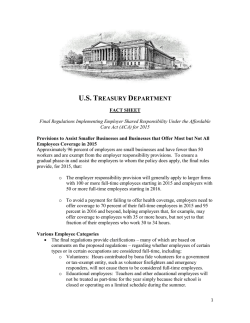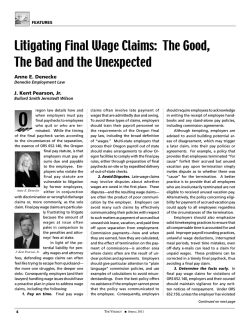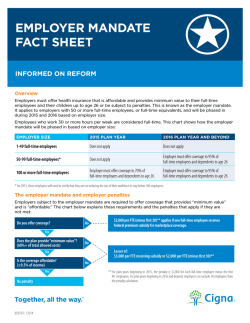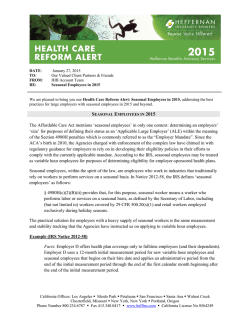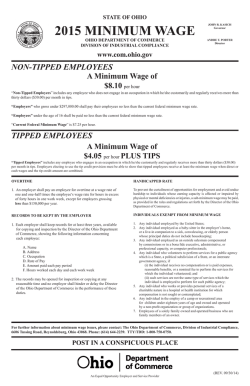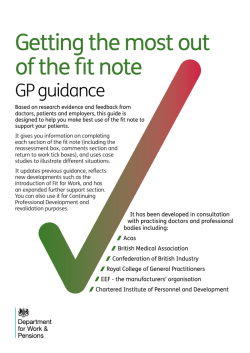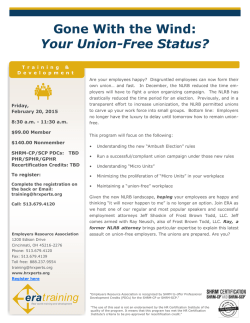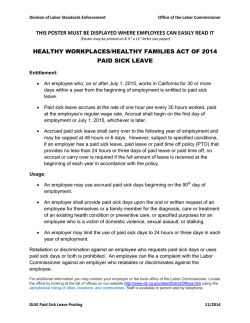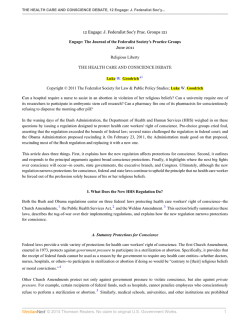
The Affordable Care Act Employer Mandate Cases: Regulation
Oxford Journal of Law and Religion, (2013), pp. 1–6 doi:10.1093/ojlr/rwt004 The Affordable Care Act Employer Mandate Cases: Regulation versus Conscience on its Way to the United States Supreme Court ERIC C. RASSBACH* Although the United States Supreme Court decided the ‘Obamacare case’1 to great fanfare in June 2012, 8 months later it is clear that the Court has by no means seen the last of the challenges to the Patient Protection and Affordable Care Act.2 Indeed, the Justices’ opinions in that case signalled that they knew there would be additional challenges to the Act.3 Their November 2012 decision to grant, vacate, and remand a petition raising a number of additional challenges to various parts of the Act served as further confirmation that NFIB v Sebelius was only the beginning of years of litigation concerning the Act.4 This commentary focuses on one slice of that litigation that is almost certain to reach the Supreme Court: the conflict between regulation and conscience * Attorney-at-law (JD, Harvard 1999). The author is Deputy General Counsel at The Becket Fund for Religious Liberty, a non-profit law firm based in Washington, DC, that represents people of all faith traditions, including Buddhists, Christians, Hindus, Jews, Muslims, Sikhs, and others. The Becket Fund represents plaintiffs who have brought six separate lawsuits challenging the application of the Patient Protection and Affordable Care Act on religious freedom grounds. The Becket Fund also operates an information clearinghouse on religious freedom challenges to the Act’s employer mandate at <www.becketfund.org/hhsinformationcentral>. Email: [email protected] 1 The case was National Federation of Independent Business v Sebelius, 132 S Ct 2566 (2012). It centered on whether Congress had power under the Constitution to enact the ‘individual mandate’ provisions of the Patient Protection and Affordable Care Act, 124 Stat 119, which requires most American citizens to obtain health insurance, either through their employer, or by purchasing it on their own. The constitutional challenges to the individual mandate centered on whether Congress had the power under Article I of the Constitution to force citizens to purchase a particular product. In a set of fractured opinions, the Court held that neither the Commerce Clause, US Const, art I, sec 8, cl 3, nor the Spending Clause, US Const, art I, sec 8, cl. 1, gave Congress power to impose the individual mandate, but that the Taxing Clause, US Const, art I, sec 8, cl 1, did. NFIB v Sebelius, 132 S Ct at 2598. Chief Justice Roberts cast the deciding vote in favour of the Act. 2 The Act is the legislative centerpiece of a comprehensive healthcare reform enacted by Congress in 2010. One of the stated goals of the healthcare reform is to ensure that every American will have health insurance. Current estimates are that more than 30 million Americans do not have health insurance. 3 See eg NFIB v Sebelius, 132 S Ct at 2624 (Ginsburg J, concurring) (‘A mandate to purchase a particular product would be unconstitutional if, for example, the edict impermissibly abridged the freedom of speech, interfered with the free exercise of religion, or infringed on a liberty interest protected by the Due Process Clause.’). 4 Liberty University v Geithner, 81 USLW 3282 (25 November 2012) (Mem.). ß The Author 2013. Published by Oxford University Press. All rights reserved. For Permissions, please email: [email protected] 2 Oxford Journal of Law and Religion represented by the United States Department of Health and Human Services’ preventive healthcare services mandate.5 1. The Employer Mandate One set of ongoing challenges to the Act’s legality concerns its ‘employer mandate’ provisions. Under the employer mandate, most employers with more than 50 full-time employees will be required to provide health insurance programmes to their employees that meet certain minimum requirements.6 The Act compels compliance by imposing fines. An employer that offers employees a healthcare plan that does not meet the minimum requirements is subject to a substantial daily fine.7 An employer with more than 50 full-time employees that does not provide any health insurance to its employees will be subject to an approximately $2000-per-employee annual fine.8 The minimum requirements include coverage for preventive healthcare services, which are not specified in the Act itself but were instead later defined by the Department of Health and Human Services (‘HHS’), the main federal government agency tasked with administering the Act.9 Under regulations promulgated in August 2011, HHS included among the required preventive healthcare services contraceptive drugs and devices (including some known to act post-fertilization) and related counselling services.10 The decision by HHS to include these services in every employer healthcare plan created an immediate outcry among religious employers and individuals who believe and teach that abortion or contraceptives are morally wrong.11 In the subsequent regulatory consultation process, more than one hundred thousand comments objecting to the mandated inclusion of these preventive services were submitted to HHS. The focus of these comments was the fact that many religious groups teach that assisting anyone, including their employees, to engage in immoral conduct is itself immoral and forbidden by their religious beliefs. In the view of these groups, the preventive healthcare services mandate puts them in the position of having to choose between 5 This commentary went to press in late January 2013. Given the pace of litigation regarding this question, many additional significant court rulings are likely to have been made by the time this commentary is in print. In addition, the federal government has promised to announce a change to the scope of the mandate by the end of March 2013. See Wheaton College v Sebelius, 2012 WL 6652505 at *1 (DC Cir 18 December 2012) (noting that the government promised the Court of Appeals for the DC Circuit that ‘it would publish a Notice of Proposed Rulemaking for the new rule in the first quarter of 2013 and would issue a new Final Rule before August 2013’.). 6 42 USC sec 300gg-13(a)(4). In addition to the religious freedom challenges to the Act, several other likely challenges to the employer mandate are not addressed here. See, eg, Jonathan H Adler and Michael F Cannon, Taxation Without Representation: The Illegal IRS Rule to Expand Tax Credits Under the PPACA forthcoming, Health Matrix: Journal of Law-Medicine (manuscript available at <http://ssrn.com/abstract=2106789>) accessed 14 December 2012 (arguing that fines for non-compliance with the employer mandate are illegal in states where the federal government is setting up a healthcare exchange). 7 26 USC sec 4980D. 8 Many employers in the retail and foodservice industries have begun reducing employee hours to below 30 hours per week in order to avoid the 50 full-time employee threshold triggering fines. 9 42 USC sec 300gg-13(a)(4); 76 Fed. Reg. 46621, 46626 (3 August 2011). 10 ibid. 11 Many religious groups in the United States, including Catholics, Orthodox Jews, and many Protestant and Hindu groups, teach that life begins at conception. Thus contraceptives that act post-fertilization are considered abortion-causing. 3 Case Comments violating their moral precepts on the one existence-threatening government fines on the other. hand and massive, 2. Litigation against the Mandate The first lawsuit challenging application of the employer mandate was filed in November 2011 on behalf of Belmont Abbey College, a Catholic college in North Carolina that is overseen by Benedictine monks.12 The lawsuit raised claims under the Religious Freedom Restoration Act,13 the Free Exercise, Establishment, and Free Speech Clauses of the First Amendment to the United States Constitution, and the Administrative Procedures Act. In response to that lawsuit and others, the Department of Health and Human Services has taken several regulatory actions since the mandate was promulgated. First, in January 2012 HHS announced that it would not change the mandate as initially proposed in August 2011 but instead would provide a one-year ‘safe harbor’ from enforcement by three federal government agencies.14 Second, after further outcry, in February 2012 President Obama announced at a news conference that HHS would create the safe harbor and would also resolve the problems caused by the mandate by exploring the possibility of creating a system under which insurance companies paid by religious employers would cover the objected-to services.15 Third, in March 2012, HHS issued an ‘advanced notice of proposed rulemaking’, which proposed to consider initiating a new rulemaking process to remedy the problems caused by the mandate and to conduct ‘listening sessions’.16 Fourth, after plaintiffs in one lawsuit demonstrated that Protestant employers that object to abortion but not contraceptives generally were not included in the ‘safe harbor’, HHS revised the safe harbor to include those employers.17 In the fifteen months since the first lawsuit was filed, 43 additional lawsuits have been filed, in almost every US judicial circuit.18 Plaintiffs include religious colleges and universities, church entities, religious charitable organizations that help the homeless and the impoverished, family-owned businesses, individuals, and several state governments. The great number of lawsuits filed, and their increase over time (the latest lawsuit before this article went to press was filed in late January 2013) is an indication of the very high stakes for religious employers. Many religious 12 The author represents Belmont Abbey College in the lawsuit. 42 USC sec 2000bb et seq. Belmont Abbey College v Sebelius, 2012 WL 2914417 (DDC 18 July 2012), reversed in part and held in abeyance, Wheaton College v Sebelius, 2012 WL 6652505 (DC Cir 18 December 2012). 15 See Center for Consumer Information and Insurance Oversight and Centers for Medicare and Medicaid Services, Guidance on the Temporary Enforcement Safe Harbor for Certain Employers, Group Health Plans and Group Health Insurance Issuers with Respect to the Requirement to Cover Contraceptive Services Without Cost Sharing Under Section 2713 of the Public Health Service Act, Section 715(a)(1) of the Employee Retirement Income Security Act, and Section 9815(a)(1) of the Internal Revenue Code, at <http://cciio.cms.gov/resources/ files/Files2/02102012/20120210-Preventive-Services-Bulletin.pdf> accessed 14 December 2012. 16 Certain Preventive Services under the Affordable Care Act, 77 Fed Reg 16,501 (21 March 2012). 17 Department of Health and Human Services, Guidance on the Temporary Enforcement Safe Harbor (15 August 2012), at <http://cciio.cms.gov/resources/files/prev-services-guidance-08152012.pdf> accessed 14 December 2012. 18 A full list of the cases is available at <www.becketfund.org/hhsinformationcentral> accessed 26 January 2103. 13 14 4 Oxford Journal of Law and Religion organizations would be forced to close as a result of the fines imposed in enforcing the Act. Other businesses would be required to terminate or radically reduce their employees’ hours. Imposition of the employer mandate in its current form would thus mark a significant rupture in how church and state relate to one another in the United States. 3. The Legal Arguments Perhaps the chief irony of the employer mandate litigation is that despite the very high stakes and great number of lawsuits, the main law at issue is relatively straightforward.19 The Religious Freedom Restoration Act (‘RFRA’)was passed in 1993 by unanimous consent in the House of Representatives and by 97-3 in the Senate and signed into law by President Clinton as a means of ‘overruling’ a prior United States Supreme Court decision that had significantly limited religious protections under the First Amendment.20 Under the Religious Freedom Restoration Act, government may not impose a substantial burden on a particular religious exercise unless it can show that the imposition of the burden both furthers a compelling governmental interest and is the least freedom-restrictive alternative available to the government.21 The Supreme Court’s most recent application of RFRA to federal government action invalidated the Drug Enforcement Agency’s attempt to impose criminal sanctions on a small New Mexico church that uses a banned hallucinogenic tea in its worship services.22 In rejecting the Agency’s argument, the Court made clear that RFRA requires the government to provide exceptions wherever possible: ‘The Government’s argument echoes the classic rejoinder of bureaucrats throughout history: If I make an exception for you, I’ll have to make one for everybody, so no exceptions. But RFRA operates by mandating consideration, under the compelling interest test, of exceptions to ‘‘rule[s] of general applicability’’.’23 In the employer mandate cases, the plaintiffs all argue that the government is imposing a substantial burden—ruinous fines, in some cases running over a million dollars per day—on a specific religiously-motivated activity, their refusal to help their employees obtain abortions or contraceptives. And since the government’s compelling interest test defence must be measured ‘to the person’,24 plaintiffs argue that the government can have no compelling interest in forcing them specifically to comply with the mandate, especially where government has exempted thousands of employers from the mandate. 19 Although there are several other claims in each of the 44 lawsuits to date, including powerful ones under the First Amendment, I restrict the analysis here to the RFRA claims at issue. 20 The decision was Employment Division, Department of Human Resources of Oregon v Smith, 494 US 872 (1990). In that case, the Court drastically limited the previous First Amendment standard that had prevailed since the 1960s, replacing the former standard, which forbade ‘substantial burdens’ on religious exercise without a countervailing compelling governmental interest, with a new standard that allowed laws burdening religious exercise to pass constitutional muster if they were ‘neutral’ and ‘generally applicable’. See Smith, 494 US at 879. 21 42 USC sec 2000bb-1. The use of the ‘substantial burden’ language was designed to revive the pre-Smith standard. 22 Gonzales v O Centro Espirita Beneficente Uniao do Vegetal, 546 US 418 (2006). 23 ibid 436. 24 ibid 430. Case Comments 5 The Department of Justice, which is defending HHS regulations promulgated under the employer mandate, has thus far offered two main arguments in response to the lawsuits. First, in cases where a non-profit employer such as a religious college has brought suit, the Justice Department has argued that the plaintiffs do not have standing and their claims are not ripe. According to the Department, because religious non-profit employers currently enjoy a safe harbor from enforcement by the government, and the government has said that it might consider a new rulemaking process to alleviate the harms caused by the preventive services regulations, non-profit employers must wait to sue. This argument has been rejected by some district courts and accepted by others.25 Second, in cases where a for-profit employer has brought suit, the Department has argued that for-profit status negates any ability to bring a religious freedom claim under either the Constitution or civil rights statutes. Most courts have rejected this argument.26 But what is perhaps most notable about the Department’s arguments is what they do not say. The Department has not directly addressed the gravamen of the RFRA claim in these cases: Do multimillion dollar annual fines for seeking to avoid paying for abortion (or contraceptives) constitute a ‘substantial’ burden under the law? The Department’s difficulty in producing a robust argument in defence of the mandate on these points suggests the problems with the government’s approach. A final major problem of the Department’s approach has been its insistence that what a religious employer does is unconnected to what the insurance company it hires does. But this attempt to separate employers from the insurance they pay for is artificial. In many areas of American law, paying another to do something wrong is itself a wrong. It is a crime to pay another to commit a criminal act. It is a tort to pay another to engage in tortious activity harming another. The government has not yet explained why these principles of moral accountability may not be invoked by religious organizations when they assess their own culpability in paying for insurance that enables what they believe to be wrongful conduct. One other feature of the government’s position has been what might be termed a strategic retreat. As noted above, the government has narrowed the mandate several times in response to the lawsuits brought against the mandate, culminating in several significant concessions made at oral argument before the Court of Appeals for the DC Circuit in December 2012, when the government made a ‘binding commitment’ (1) never to apply the mandate in its then-current form to non-profit religious plaintiffs, (2) to announce a proposed 25 Compare Wheaton College v Sebelius, 2012 WL 3637162 (DDC 24 August 2012), reversed in part and held in abeyance, Wheaton College v Sebelius, 2012 WL 6652505 (DC Cir 18 December 2012), with Roman Catholic Archdiocese of NY v Sebelius, 2012 WL 6042864 (EDNY 4 December 2012) (rejecting government’s ripeness defence because ‘[t]here is no, ‘‘Trust us, changes are coming’’ clause in the Constitution.’). 26 See eg Tyndale House Publishers, Inc v Sebelius, 2012 WL 5817323 (DDC 15 November 2012) (in preliminary ruling, finding that for-profit business plaintiffs had ‘strong likelihood of success on the merits of their RFRA claim’); Korte v Sebelius, No. 12-3841, (7th Cir 28 December 2012), available at <http://sblog.s3. amazonaws.com/wp-content/uploads/2012/12/7th-CA-ruling-on-contraceptives.pdf> (for-profit business plaintiffs had ‘reasonable likelihood of success’ on their RFRA claim). But see Hobby Lobby v Sebelius, no 12-6294 (10th Cir 20 December 2012), available at <http://www.becketfund.org/wp-content/uploads/2012/12/HL10CD.pdf> (finding no likelihood of success on for-profit business plaintiffs’ RFRA claim). 6 Oxford Journal of Law and Religion change to the mandate by the end of March 2013, and (3) to make permanent changes to the mandate by the end of July 2013.27 Additional concessions during the course of litigation cannot be ruled out. 4. What Next? Absent a major additional regulatory retreat by HHS, one or more of the cases challenging the preventive healthcare services mandate are very likely to come before the United States Supreme Court. The subject matter is too important, and the lower appellate courts too likely to be divided, for the ultimate decision to be made by any other body. When one of these cases does reach the Court, we will learn which will prevail: the government’s assertion of regulatory imperative or the traditional American respect for religious conscience. 27 See Wheaton College v Sebelius, 2012 WL 6652505 at *1-*2 (DC Cir 18 December 2012) (noting concessions and stating ‘We take the government at its word and will hold it to it.’).
© Copyright 2026
